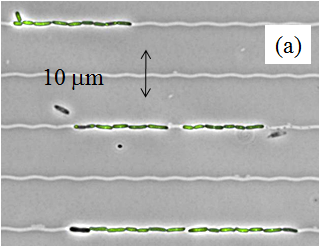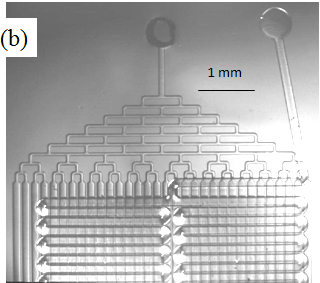During the academic year, Fall09 - Spring10, Dr. Kim,
the facility director ,designed, built and tested devices for a number of MRSEC
and outside users.
The application of
semi-conductor processing technology to microfluidics permits the reduction of ordinary chemical laboratories
to the size of a microprocessor chip, hence the name "lab-on-a-chip". One
device that we have developed is called the Phase Chip which can store 1000
different samples in a square inch. Each sample contains 0.11 - 10 nanoliters of fluid and each
compartment is in contact with a semi-permeable membrane which permits the
rapid and reversible exchange of solvents. Our chip is designed for the study
of liquid crystals, but we also have built chips for protein crystallization, a
problem of importance to biology.
 (a) Microfluidic
(a) Microfluidic
Device to Study of the Structure of Chromosomes (Dr. Wiggins). This is part of
the "confined polymers" thrust. The origin of replication of the E-coli
chromosomes is labeled with a parB-GFP fluorescent fusion protein to track the locus
dynamics in live cells during chromosome replication. The cells are loaded
using a permeation pump designed into the microfluidic device which is made from agarose
gel so that drugs and growth media can be infused into the cells.
 (b) Top view of a Microfluidic oxygenation device for brain tissue culture (Prof. Lisman)
(b) Top view of a Microfluidic oxygenation device for brain tissue culture (Prof. Lisman)
to study neurons. Gas and fluid channels are separated by a thin (5 micron)
PDMS membrane.